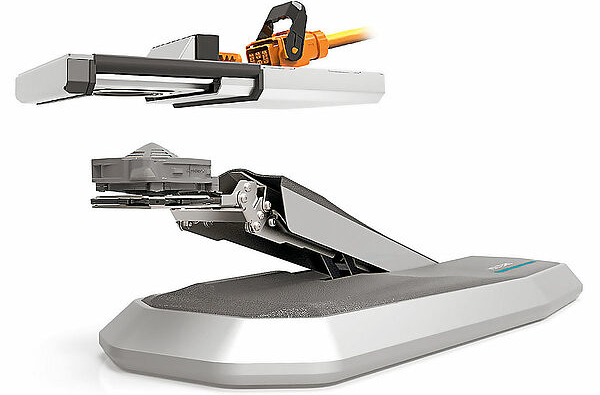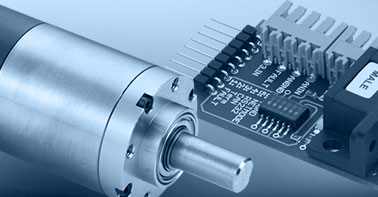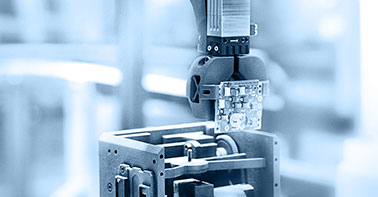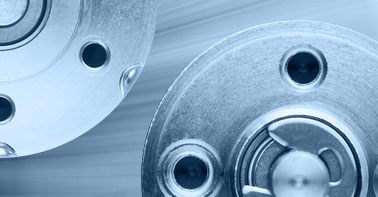- info@ems-ltd.com
- 0118 9817391
Home > Sectors > Environmental & Safety > Automatic EV charging
Automatic EV charger driven by DC motors

Electric vehicle (EV) adoption is growing fast. And as the ban on new petrol and diesel cars approaches, we’ll soon all be swapping gas for electricity.
But rising EV figures poses a unique problem: how will they be charged? Bulky cables and charging infrastructure could cause a nuisance on our streets. And while wireless chargers offer a partial solution, their inefficiency means they’re not ready for mass rollout either.
This case study introduces Volterio’s automatic EV charging solution, which combines efficiency with convenience. Learn how FAULHABER's DC motor range, only available in the UK & Ireland through EMS, was crucial in achieving Volterio's ambitious design.
Current EV charging problems
Charging stations can be an eyesore. And cables and plugs on pavements can be dangerous trip hazards, especially in the dark. These obstructions can also pose accessibility issues for those with reduced mobility using a wheelchair.
In response to these issues, some EV charger manufacturers have opted for a wireless solution. These typically make use of inductive charging principles using coils embedded in the road surface or garage floor.
While these embedded chargers don’t come with the same visual or physical problems, they aren’t a flawless solution. Having to embed the charger within the floor comes at a cost. And installations on public roads will incur local disruption while work is being completed. In a mass-scale rollout, this could be seriously disruptive.
Power and efficiency of inductive chargers is another concern. In most cases, the maximum output sits at just three kilowatts, making charging a slow process. Inductive charging is not as efficient as wired charging, so customers may pay for power they can't use. And if you don't park the car in the optimum position, these issues become even more noticeable.
Combined, these issues highlight the problems with current wireless EV chargers. They simply can't keep up with soaring demand for fast, convenient charging systems.
Matching convenience with efficiency
How can you make a wireless charger as efficient as a wired one while keeping its streamlined design? Volterio has the answer, with a compact EV charger that automatically plugs into the car. When inactive, the charger has a height of just six centimeters. As soon as a car is parked over it for charging, a robotic arm extends from the device. This arm contains the connector, which will look for its counterpart underneath the car.
Volterio’s EV charger offers customers convenience. There’s no need to get out to plug in your car or waste valuable time making minor adjustments to park it in the right spot. The robotic arm can find connections within a range of 50 by 50 centimeters. It also doesn't matter if your car is parked at an angle.
Making use of a physical connection means that Volterio’s solution has a much higher output than wireless chargers, with a capacity of 22 kilowatts. Even the largest car batteries can be charged in just a few hours. And the inconspicuous design of the charger means it doesn’t present the same visual or physical disadvantages of large cables and infrastructure.
Compact design with DC motors
In developing the prototype, a particular area of focus was the three motors moving the robot arm along the three axes. Volterio sought to build a device as flat as possible, meaning an extremely limited space to work with. At the same time, the arm needed to be strong enough to hold a heavy connector and cabling.
Volterio’s search for a suitable motor system led to FAULHABER. After much consultation and testing, it was determined that brushed DC motors from the CR series would be the ideal solution. With low-wear graphite commutation, extremely powerful neodymium magnets and a high copper content in the rotor windings, motors in the CR series are the most powerful of FAULAHBER’s entire DC motor range.
A shockproof all-steel housing with corrosion-resistant coatings means these motors are robust enough to operate in all weathers. Their low rotor inertia offers a high dynamic performance, helping the robotic arm establish the connection in under 15 seconds.
The CR series of brushed DC motors can reach torques of up to 224 mNm, with sizes ranging from a diameter of 23 to 38 mm for extremely compact devices. And a broad range of compatible gearheads, also from FAULHABER, enabled improved torque and speed control to further enhance motor performance.
The inclusion of compact, high-power DC motors from FAULHABER’s CR series ultimately led to a successful prototype. After extensive validation in testing, Volterio began exploring series production of the automatic EV charging prototype with several leading OEMs.
EMS is the exclusive distributor of FAULHABER motors for the UK & Ireland. To find out more about the CR brushed motor series and other types of motor available through EMS, please get in touch with a member of the team today.









